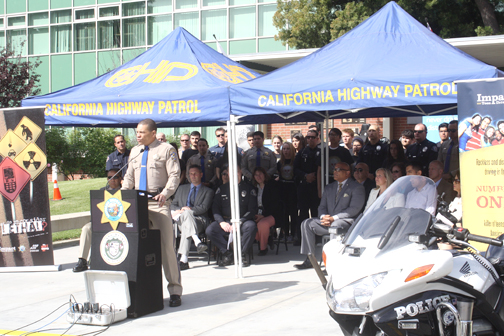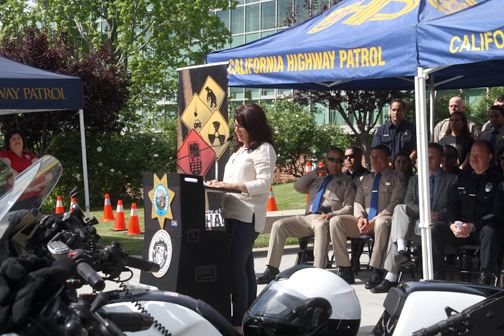By Mary O’KEEFE
On Thursday, California Highway Patrol hosted a California Teen Safe Driving event at Clark Magnet High School as part of April’s Distracted Driving Awareness Month.
“I want everyone to look around at the incredible turnout of resources that have been brought to address this issue that affects so many people, not only in California but across the country,” said Mark Garrett, CHP Southern Division assistant chief.
The resources Garrett was speaking about included representatives from Crescenta Valley Town Council, Glendale Unified School District, Glendale Police Dept., AT&T and Impact Teen Drivers.
“Traffic accidents are the number one killer of teens across the country,” Garrett said. “We need to change the culture starting from day one with young drivers, and drivers in general, when it comes to operating motor vehicles.”
Last year about 40,000 people died in car crashes, according to the National Safety Council. This makes it the highest number of motor vehicle deaths in nine years.
“This month we are taking it to a higher level and focusing even more on education through school programs, our partnerships with law enforcement and non-law enforcement partners to really focus on distracted drivers,” he said.
With an emphasis on teen distracted driving.
“We all take teen driving and distracted driving very seriously,” added Deputy Chief Carl Povilaitis from GPD. “I can’t over emphasize enough that when you are driving a car, driving is a full-time job. I don’t think any of us would drive down the street and close our eyes for seven to eight seconds while we are driving. Yet a lot of people don’t think twice about picking up their telephone and looking at a text, which is basically the same thing.”
AT&T Public Affairs representative Ryan Minniear added that it is not only texting that causes a driver to be distracted. Drivers check their social media, too.
“People are doing more than texting these days; they are surfing the net and posting to social media,” he said.
Povilaitis shared a story of a distracted driving accident.
“A number of years ago in the Glendale area there was a driver, a 20-year-old young lady, who was driving in the downtown area and happened to be texting while she was driving. She missed a stop sign, she missed seeing a pedestrian in the crosswalk, an older gentleman,” he said.
That gentleman was struck and killed.
“That changes lives. It changed the lives of the family [of the victim], and changed the life of the driver,” he said. “It only takes that moment for a tragedy to happen.”
Gonzalo Aranguiz, who was from Chile, shared his story as well.
“It was the worst day of my life. It was my last year of college at Cal Poly Pomona,” he recalled.
In 2003, he was an engineering student. He spoke of his parents’ sacrifice when they paid for his education. He spoke of how bright his future looked as he headed off in his car driving to his new internship.
“I was going around a curb and saw my phone drop on the floor; [it was] a simple decision to pick it up. By leaning toward it my car shifted toward the side of the curb and that is when I felt the impact,” Aranguiz said.
He had hit and killed a cyclist. He said at that moment, seeing the victim on the ground, is something he sees in his mind every day. He is now living with the guilt, guilt for the pain and suffering of the victim’s family and the pain he has put his own parents through. He wanted to share his story to help educate others.
“Simple choices, like picking up a phone, can change your life,” he said.
Dr. Kelly Browning, executive director of Impact Teen Drivers, talked about the statistics of distracted driving.
“In a recent study, 98% of people [questioned] reported texting while driving as being extremely dangerous, but of that same [group] 70% reported having done it,” she said. “The propensity of people rationalizing the ‘not me’ mentality is a big part of the problem.”
Research commissioned by AT&T found that nearly four in 10 drivers use or check social network while driving, and 75% of teen drivers say texting while driving is “common among their friends.” And 78% of teen drivers stated, in the study, they are likely not to text and drive if friends tell them it’s wrong or stupid.
Armina Gharpetian, president of the GUSD school board, said she was a parent of driving age kids and can relate to the concerns parents have every time their child drives away.
“Every second they are behind the wheel it is scary for a parent,” she said.
She added that while it is important for teen drivers to not be distracted it is also important for them to say something if their parent, grandparent, friend or family member is looking at a text or on social media or otherwise distracted while driving.
“Tell them it can wait,” she said.
For information on distracted driving visit ItCanWait.com



